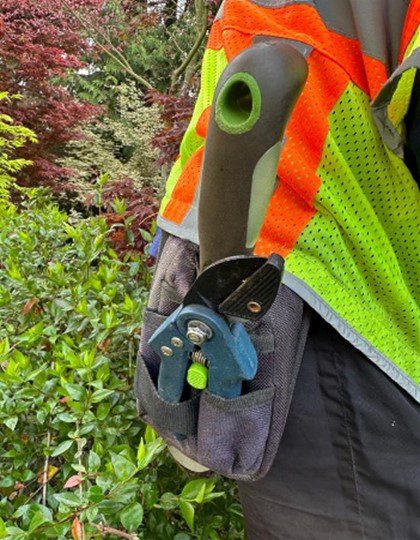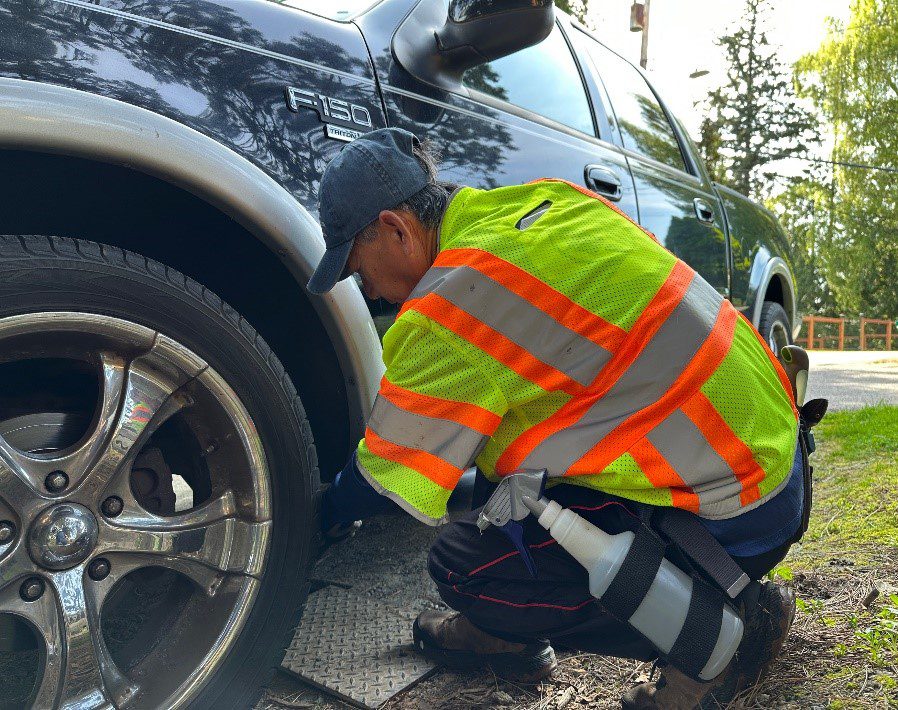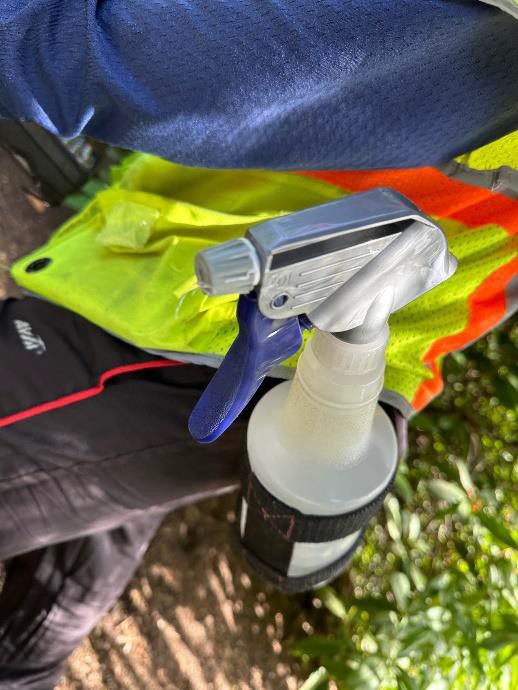
Clare McFrazier, a Strategy and Planning Advisor with Seattle Public Utilities (SPU), recently spent time with her colleague, Phong Tang, to learn about his work in Seattle neighborhoods. McFrazier and Tang are part of SPU’s Customer Care Division.
On Wednesday, May 3, I had the opportunity to job shadow with Phong Tang, a seasoned Seattle Public Utilities (SPU) Meter Reader. It was sunny, but still cool – which is Phong’s favorite type of day to work.
I watched as he checked his tool belt to ensure he had his garden shears, a spray water bottle, a trowel, and a flashlight. He carried a handheld digital ITRON device and long metal implement that looked a little like a cane with a bent tip. Phong wore an SPU safety vest, SPU baseball hat, and – very importantly – “proper” footwear.
He wears sturdy hiking boots in the drier months, but during the wetter months, rain boots are required. He walks so much that he goes through two pairs of boots each year.
Known for speed
Once the gear was checked, off we went! I had to focus to keep up. Phong’s nickname is “Lightfoot Phong” because he walks so quickly. As we were leaving the meter shop earlier that morning, Fay Thompson, one of the senior Meter Readers gave me the heads up. I was ready – and the nickname was fitting. “Lightfoot Phong” is swift for sure, but also thorough, professional, resourceful, polite, and funny.


Every meter is unique, but the goal at each house is the same: Find the meter, get the current read of water usage, enter it into the device, and don’t get a ding! A ding means the value entered is outside of expected parameters. Occasionally, the device dings even though the read is accurate. Phong rechecked this meter twice to make sure because it was the same value on this day, as at the last read.
The neighbors were outside and mentioned that the family had been gone for a couple of months. So, the static read made sense. The ding is a real-time, error-proofing built into our system. Phong said he appreciates the ding because it helps ensure all his reads are accurate. This is important to him, SPU, and the public.
Dogs? Centipedes? Snakes? No problem!
The challenges of reading each meter are as varied as the residents themselves. Some meters are literally under the fence – covered in mulch and dirt. In that case, there is just enough room to slide the cover out, but to read it, Phong was on the ground peering under the fence.
As he did that, I thought aloud: “What about dogs?” Phong knows all the dogs on his route and how to approach or avoid each one. Aside from dogs, he said he also navigates spiders, centipedes, snakes, and wasps! He just takes each challenge in stride, adjusting on the fly to new variables. This is “Lightfoot Phong” in action.
A few meters had cars parked over them. Undaunted, Phong tried to read the meter with his phone instead of asking the resident to move the vehicle because, he said, he tries not to disturb anyone when it’s so early. I had to take one photo from within the wheel well – that’s how far under the truck the meter was. No wonder our meter readers have such a great relationship with our communities!
As we continued along his route, Phong’s skill with his tools caught my attention. At one point, he whipped out the garden shears and – in no time at all – trimmed an entrance into the persistent wall of vegetation covering his next meter. Then, he nearly disappeared into the foliage, but came out, triumphant, covered in sticks and leaves.
The trowel tool, of course, was used to undo all the work of the rain or the moles, which had busily filled many of the meters with dirt. In another instance it wasn’t moles, but humans who had covered the meter with gravel. One meter was filled with water, which was odd since it had not rained in the last couple of days.


I watched as the trowel became a water removal system. Phong scooped out the water trowel by trowel, but with beaver speed. He determined that there was a small leak on the City side of the meter, which wouldn’t affect the customer’s bill or consumption. He documented the issue and called in a repair request to headquarters.
The bent cane tool fits into the meter lids to help lift them, but of course you must find the lid to lift it! Phong had a remarkable mental map of where many of the meters were, even though this is not his only route, and some routes include hundreds of meters. The ITRON device holds coded clues to the hidden treasure. Once you learn the codes, you know where the box is in relation to other landmarks such as mailboxes or electric poles.
Taking a spray bottle to new heights
However, the tool that most surprised me was the spray bottle of water. It’s such an unassuming thing and yet in the hands of a highly skilled Meter Reader like “Lightfoot Phong,” it’s a crucial contributor to the efficiency and accuracy of the meter reader process. With impressive skill, Phong was able to spray water through a partially opened lid and hit his target, which is a small glass circle no more than 2 inches in diameter.
Not that difficult you might think, but what about doing that from about 5 feet away without ever removing the bottle from its waist holster! His accuracy percentage was very high, and it meant he could clear the dirt and grime with a squirt or two and then a final squirt left just enough water on the glass to magnify the numbers so he could read the numbers from a standing position.
At just past 10:30 am, at the top of a hill in North Seattle, I went left back toward my car and Phong went right to finish his route. I snapped one last photo of him (inside a tree). We waved goodbye. I had to get back to the Seattle Municipal Tower for a meeting – one that involved sitting.
Overall, my experience shadowing “Lightfoot Phong” was informative and delightful. I reached my whole day’s step goal in under three hours. I gained a newfound appreciation for the hard work, attention to detail, community interaction, and adaptability required in the role of a Meter Reader. Phong’s dedication to his job and getting accurate reads for every customer on his route – despite the challenges and weather conditions – was truly inspiring.




